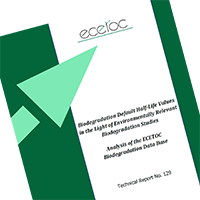Technical Report
07.04.2017
TR 129: Biodegradation Default Half-Life Values in the Light of Environmentally Relevant Biodegradation Studies – Analysis of the ECETOC Biodegradation Data Base
In a Nutshell
Biodegradation is a key process for breaking down and finally removing chemicals from the environment. The biodegradation half-life time is a key input parameter for environmental risk assessment because it helps to predict the effectiveness of biodegradation. It is widely accepted that a chemical which passes the stringent conditions of an OECD Ready biodegradability test system is assumed to be non-persistent in the environment, as it will biodegrade under a broad variety of different environmental conditions. For modelling purposes, a default half-life of 15 days in fresh water has been set for chemicals categorised as ‘readily biodegradable’. ECETOC investigated the appropriateness of the current approach of approximating half-lives on the basis of tests of ready biodegradability. To that end, a biodegradation database generated by ECETOC from published literature was analysed1. The ECETOC database comprises biodegradation studies (and derived half-lives) for the aquatic environment, from freshwater to marine conditions. This analysis critically compares biodegradation half-lives generated under a variety of environmentally more realistic conditions, e.g. in situ testing and laboratory tests with inocula taken from characterised locations and tested under non-standard ready-test conditions, with the recent default settings. The focus is on chemicals, which are categorised as ‘readily biodegradable’ in fresh water. For the 12 substances categorised as ‘readily biodegradable’, an overall median half-life of 1.95 days can be calculated. Substance specific half-life median values span from 0.9 to 11.4 days, whereas individual chemical half-lives range from 0.3 days up to 150 days for these readily biodegradable substances, reflecting the variability in test designs, inoculum characterisation and temperature regimes. The main implications of the study are twofold. It provides assurance to environmental risk assessors of the conservative nature of the default value of the biodegradation half-life. Hence, applying those default values in screening level assessment contribute to over-predicting exposure leading to conservative risk estimates. At the same time, the large variability of biodegradation half-lives in relation to in test designs, inoculum characterisation and temperature indicates the need for a discussion of the use of one single default half-life for all substances and all freshwater environments. This is of particular relevance for refining risk assessments. [1] ECETOC Biodegradation Data Base, Excel file (ECETOC, 2009).Reference
TR129: Biodegradation Default Half-Life Values in the Light of Environmentally Relevant Biodegradation Studies. Analysis of the ECETOC Biodegradation Data Base ISSN-2079-1526-129 (online) D-2017-3001-250
